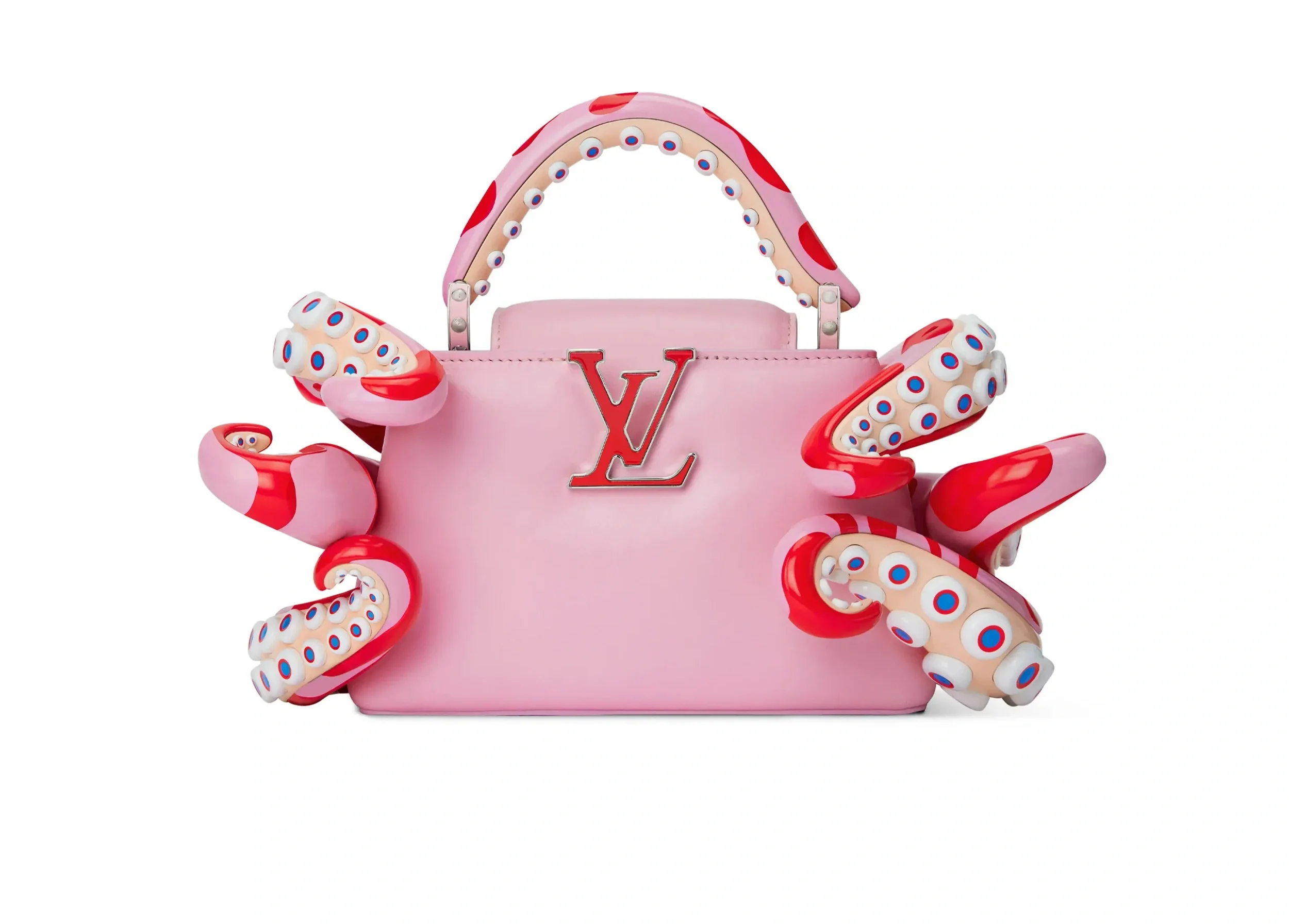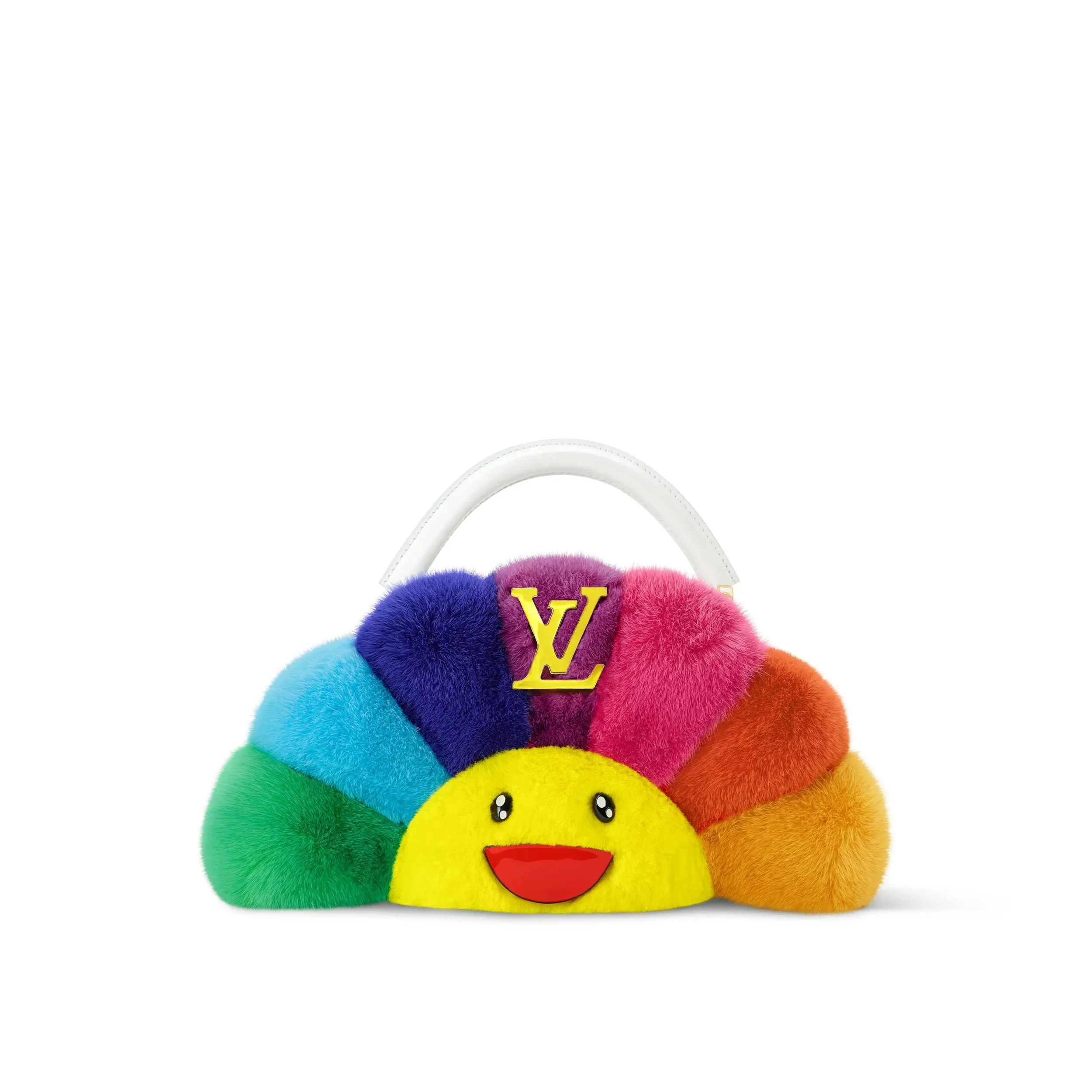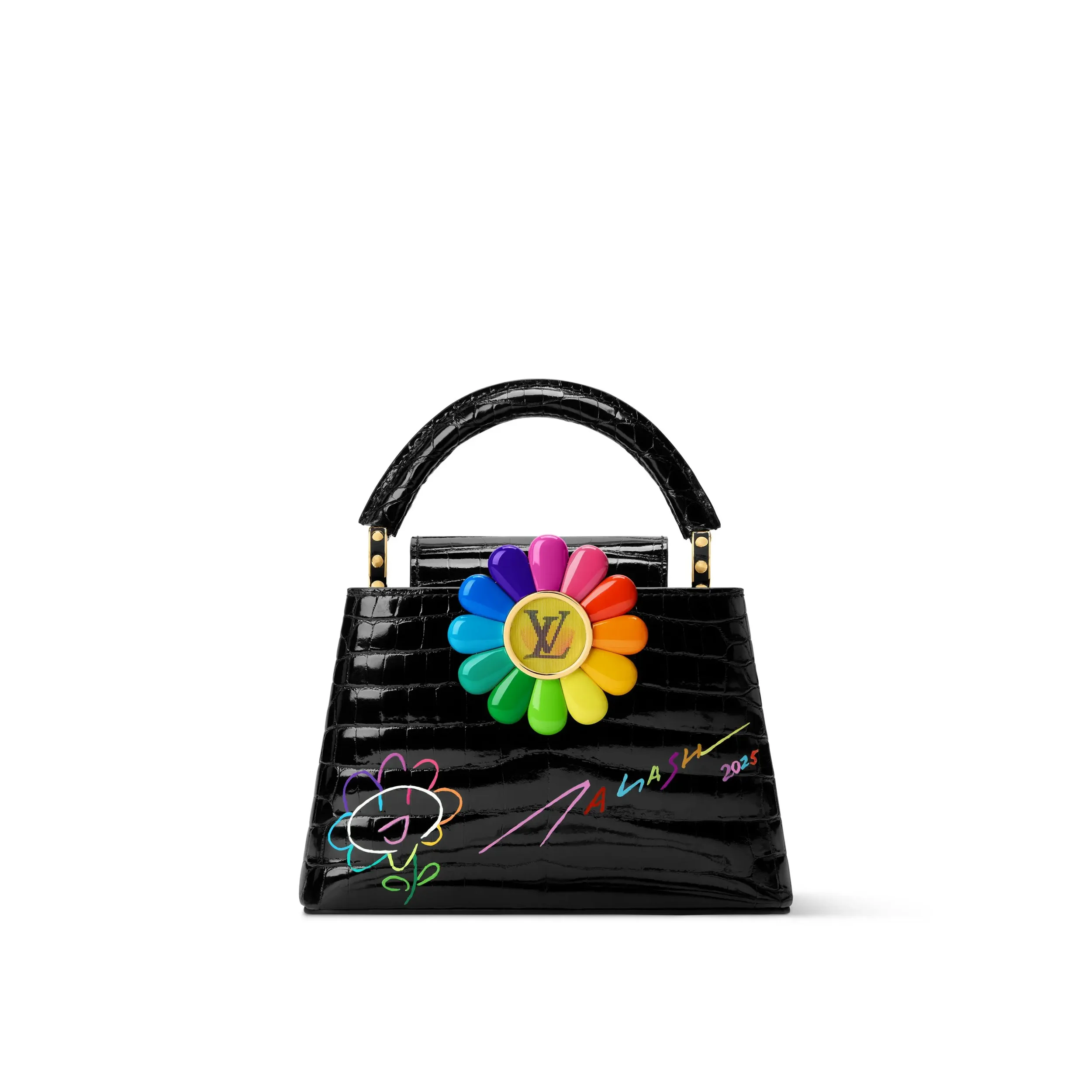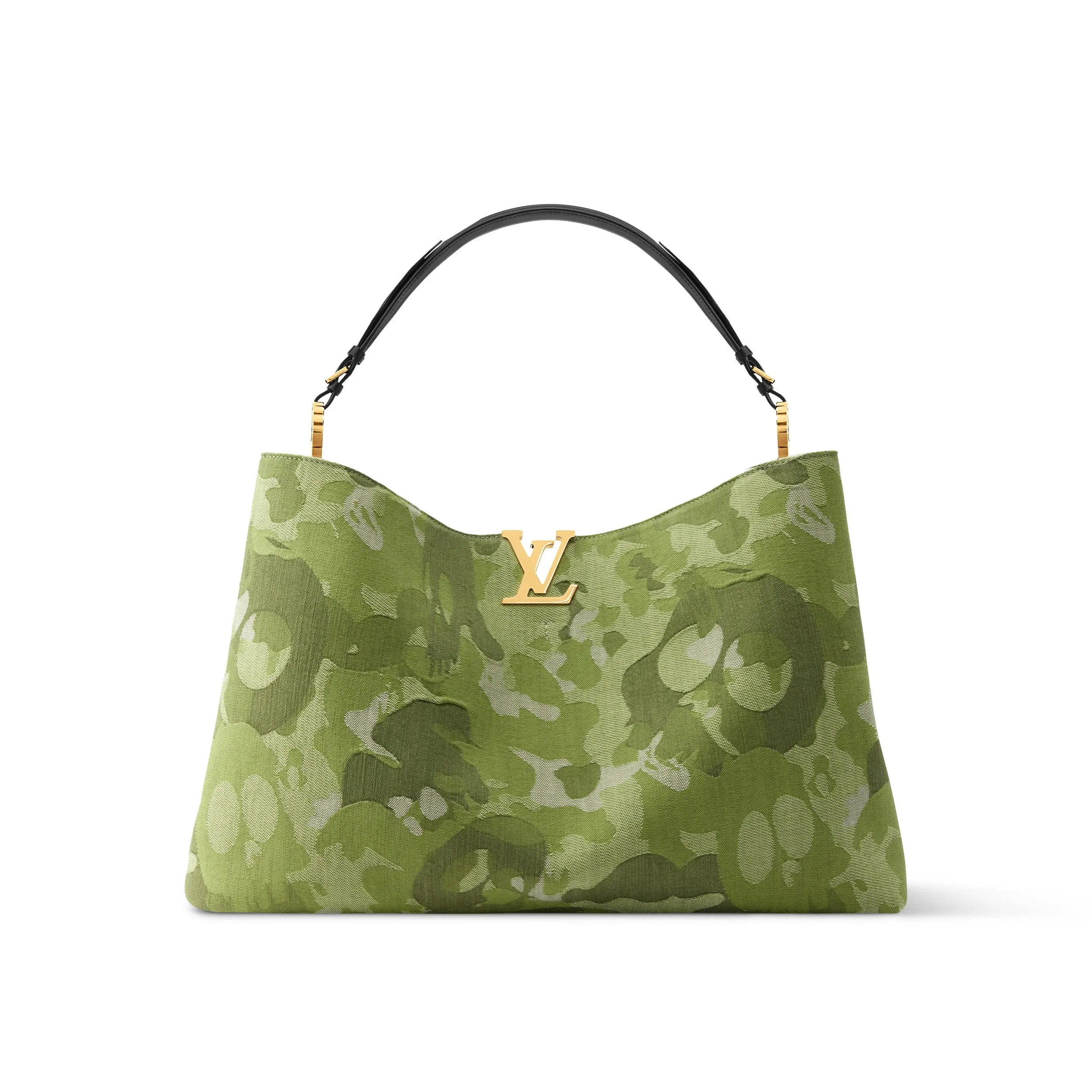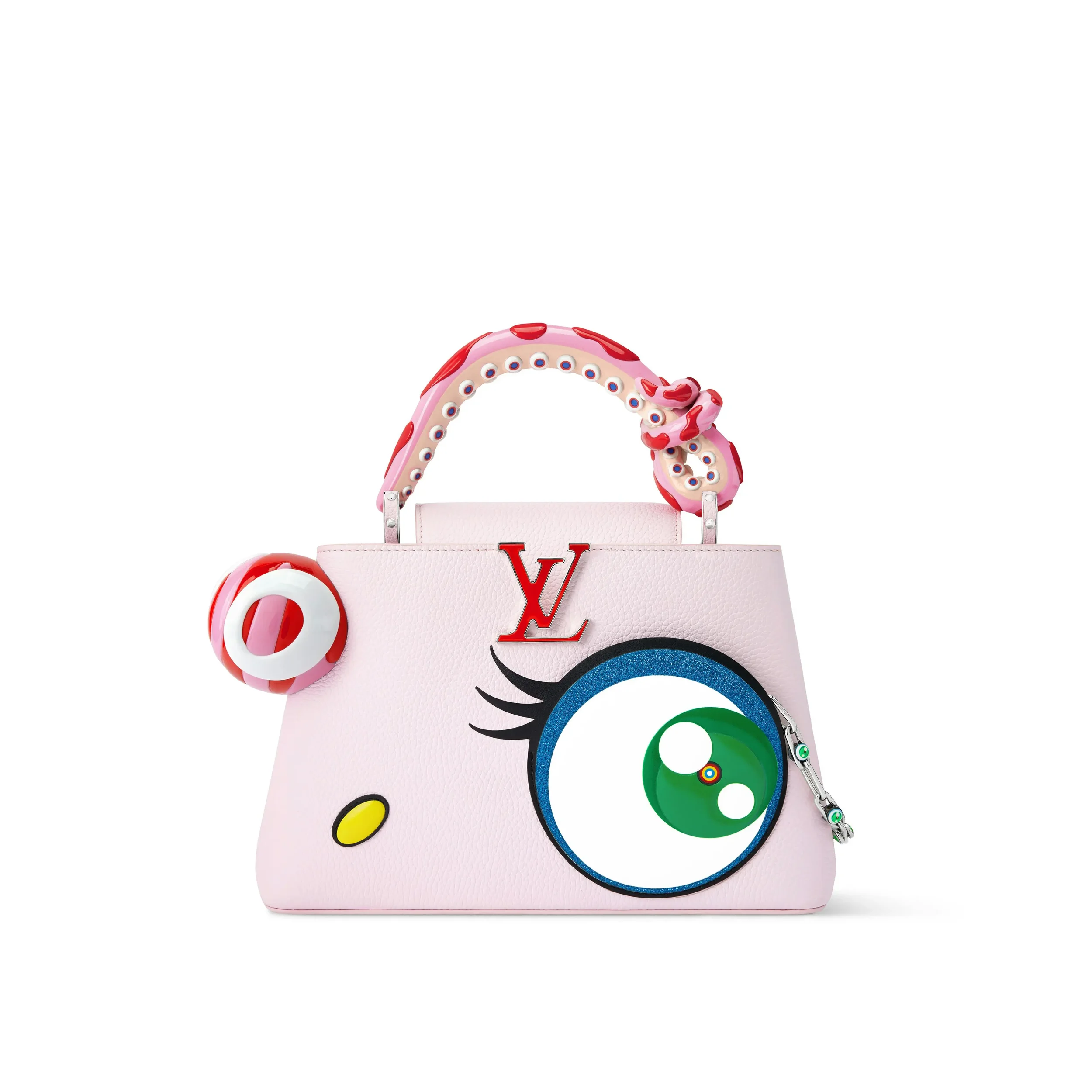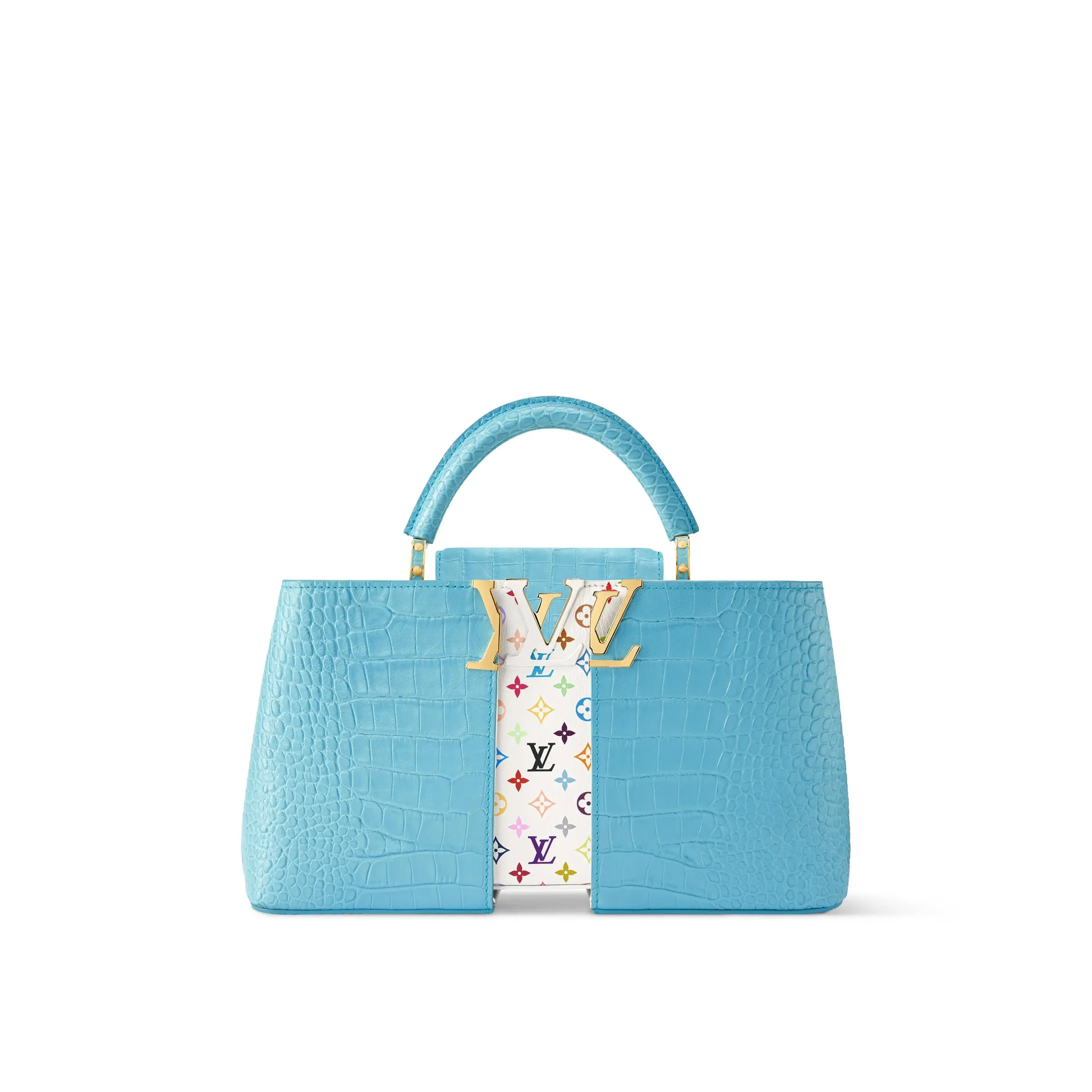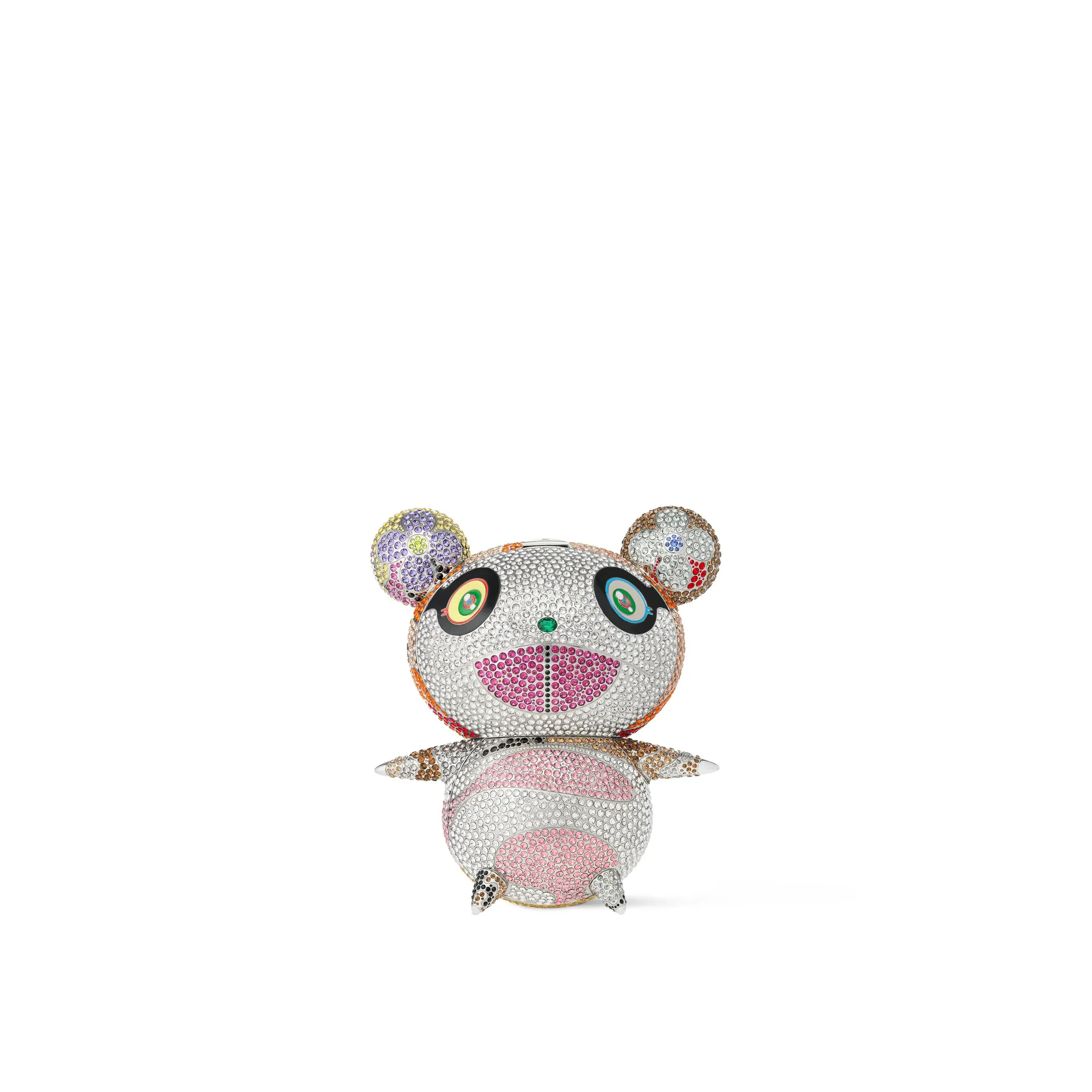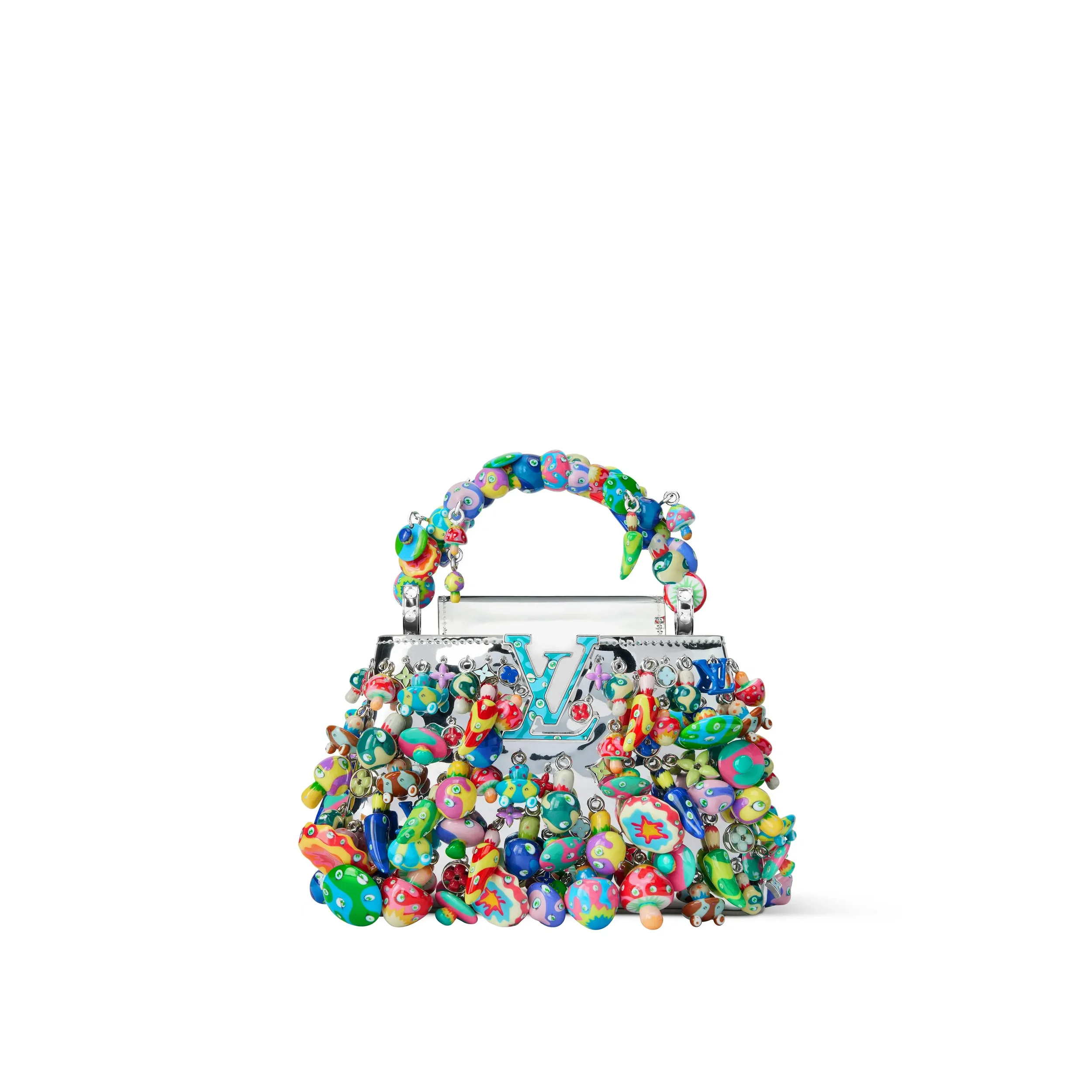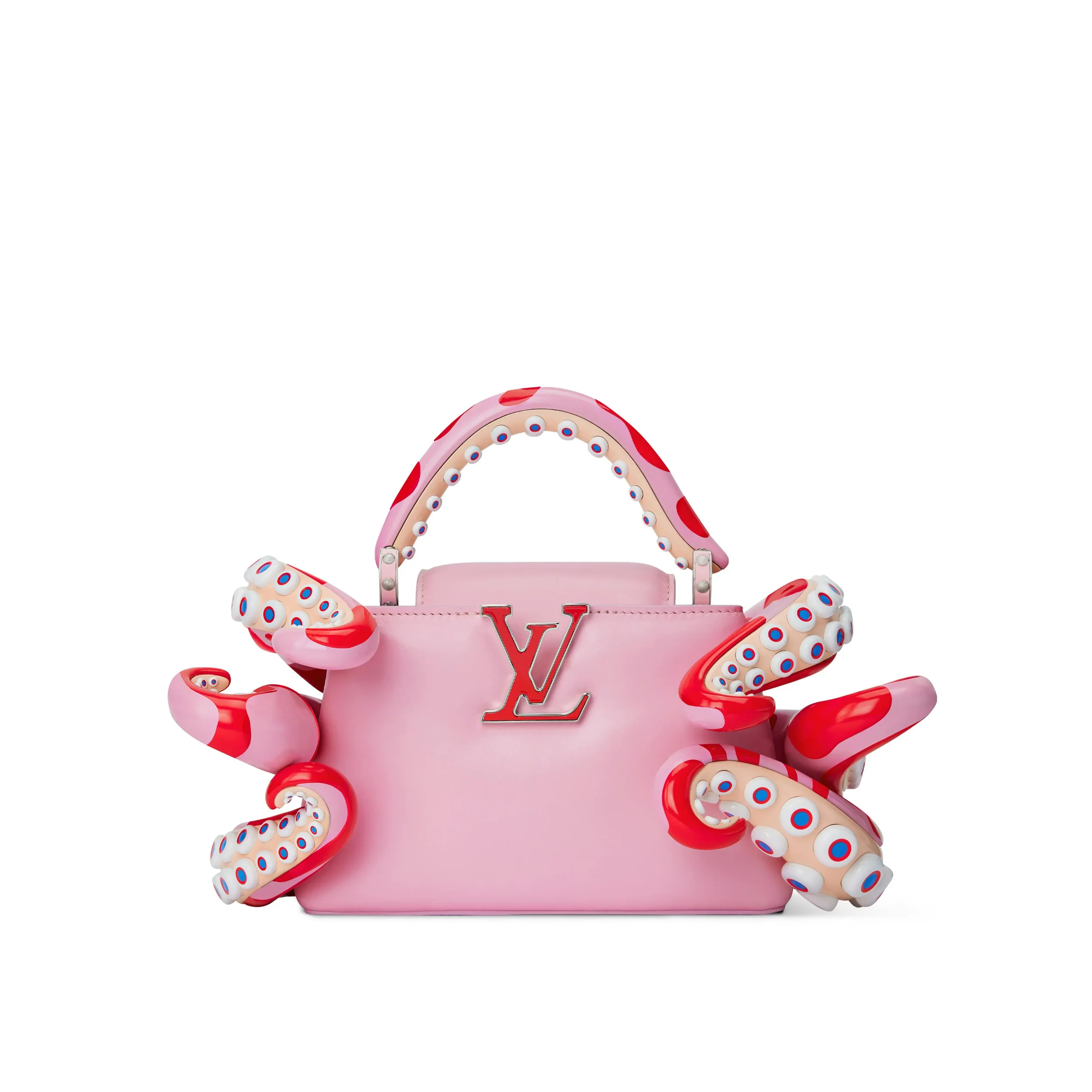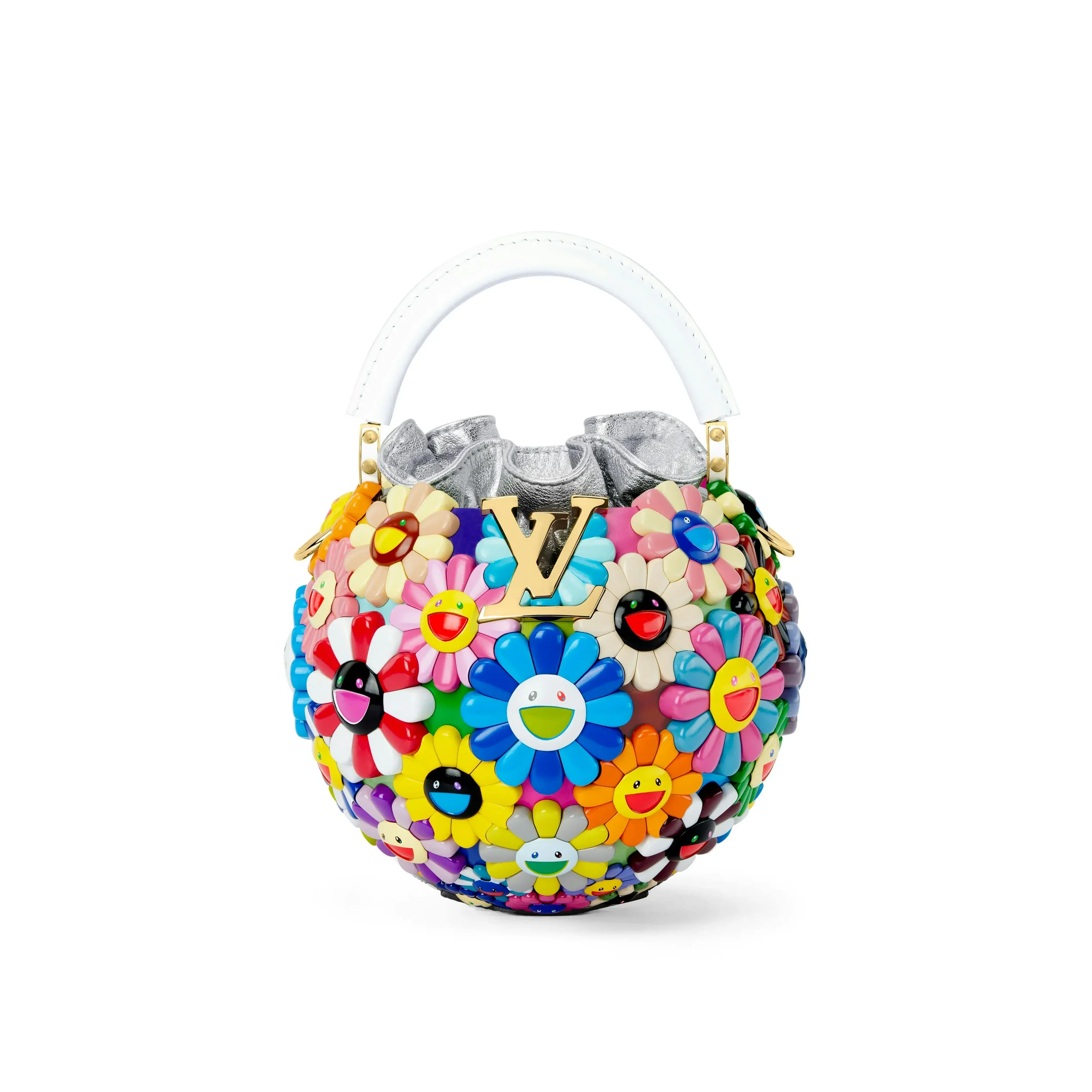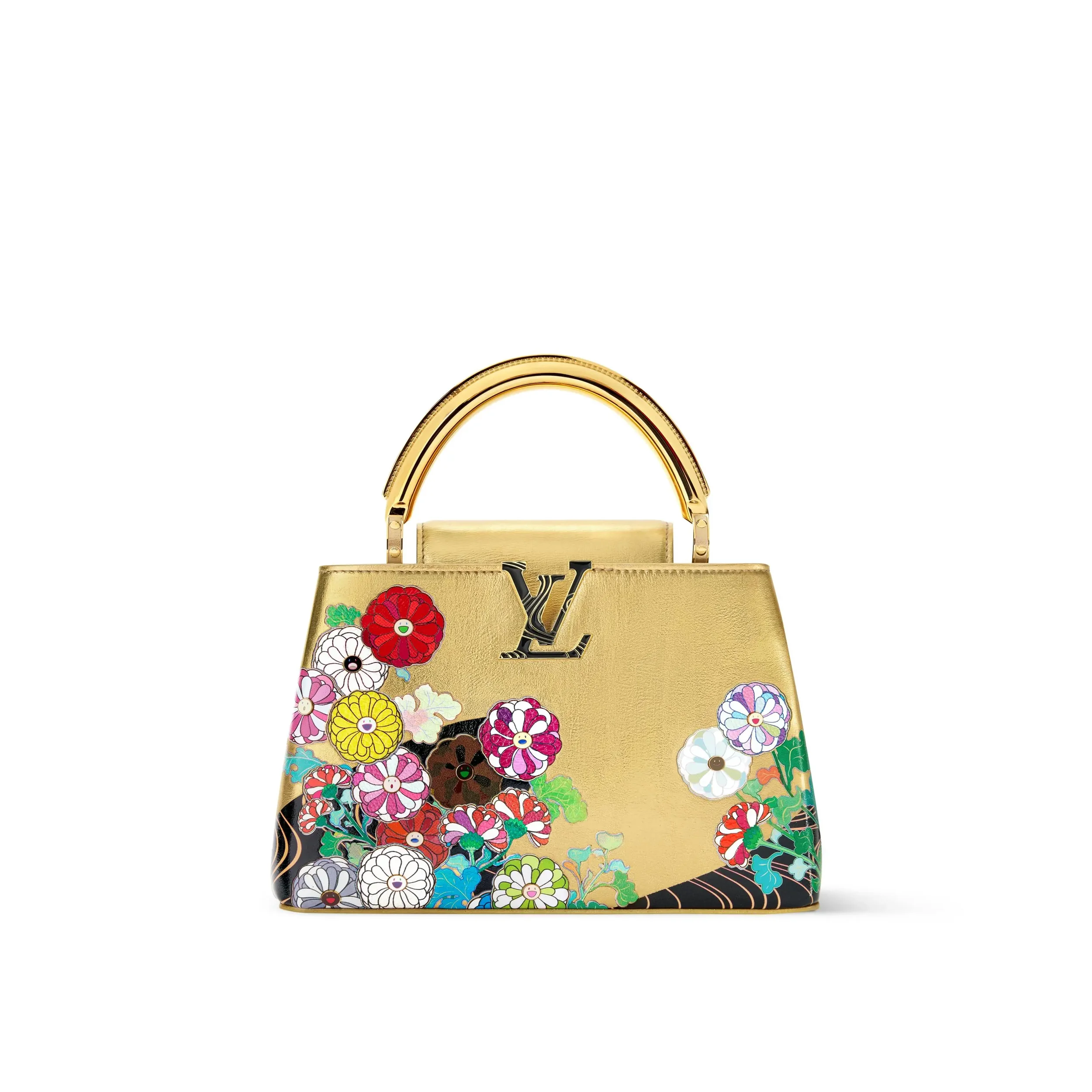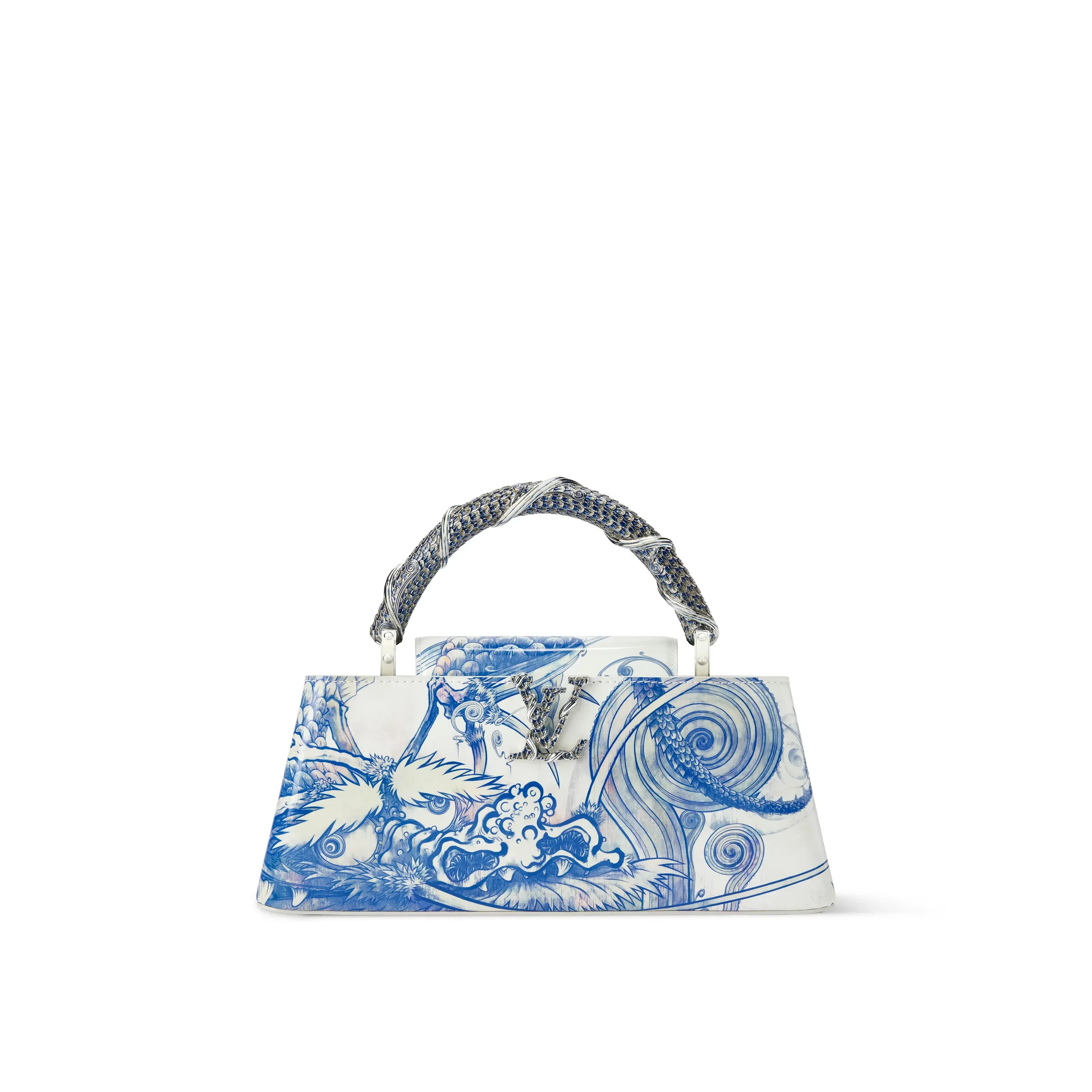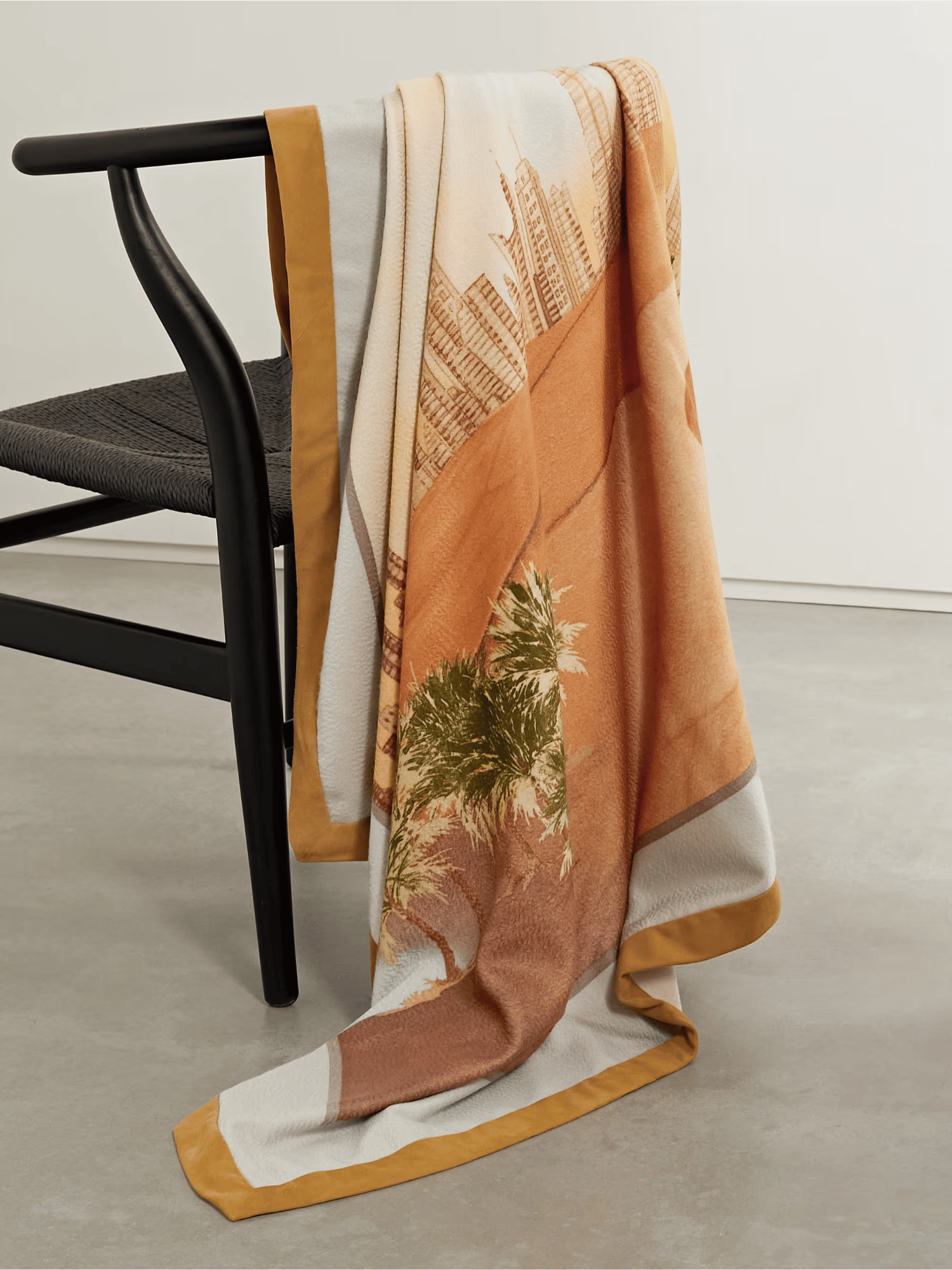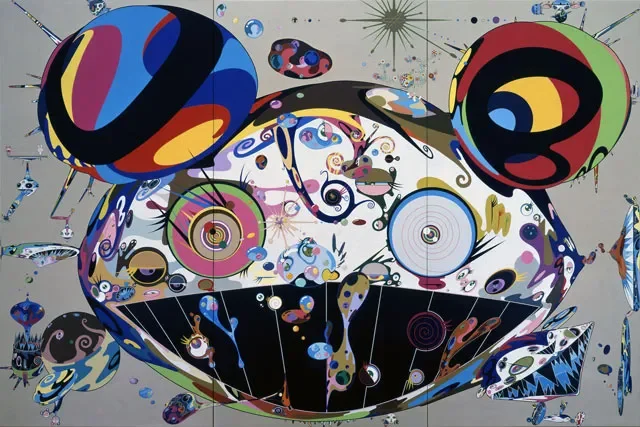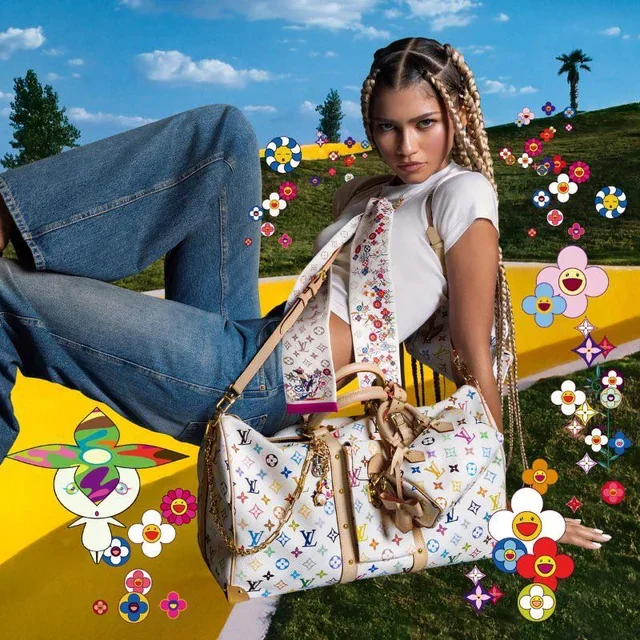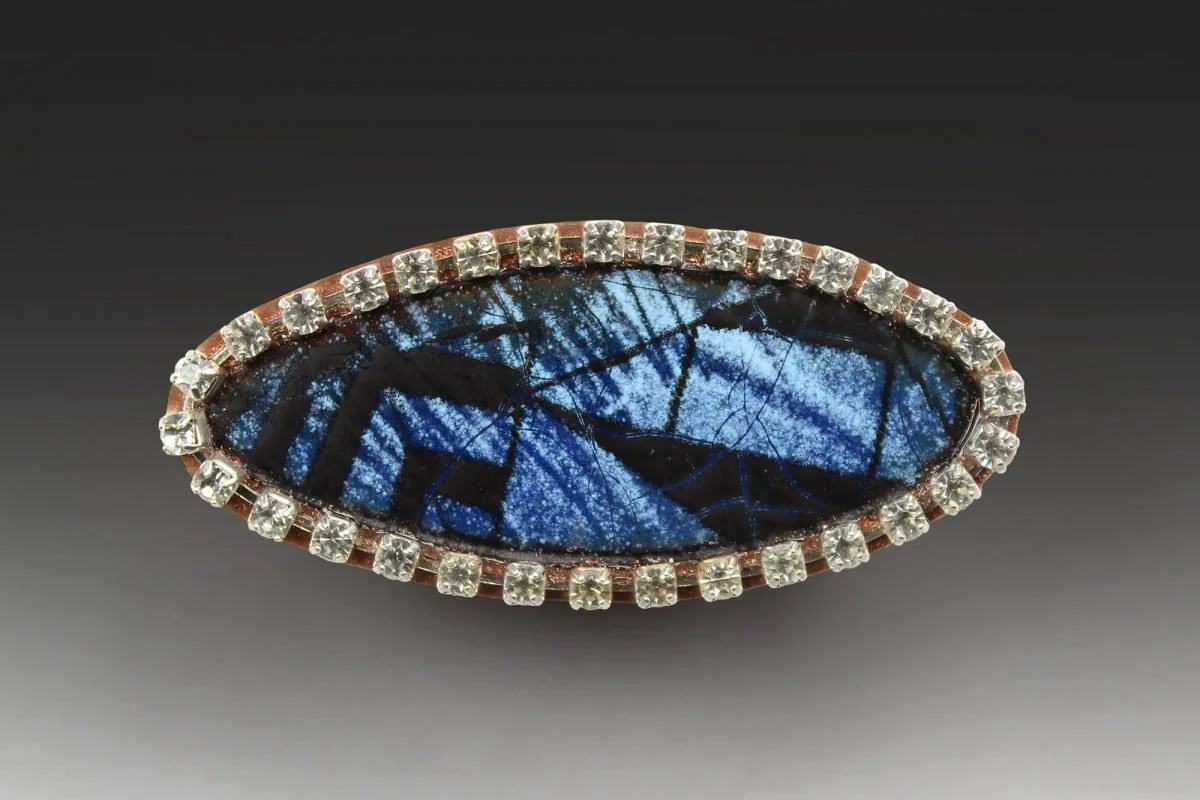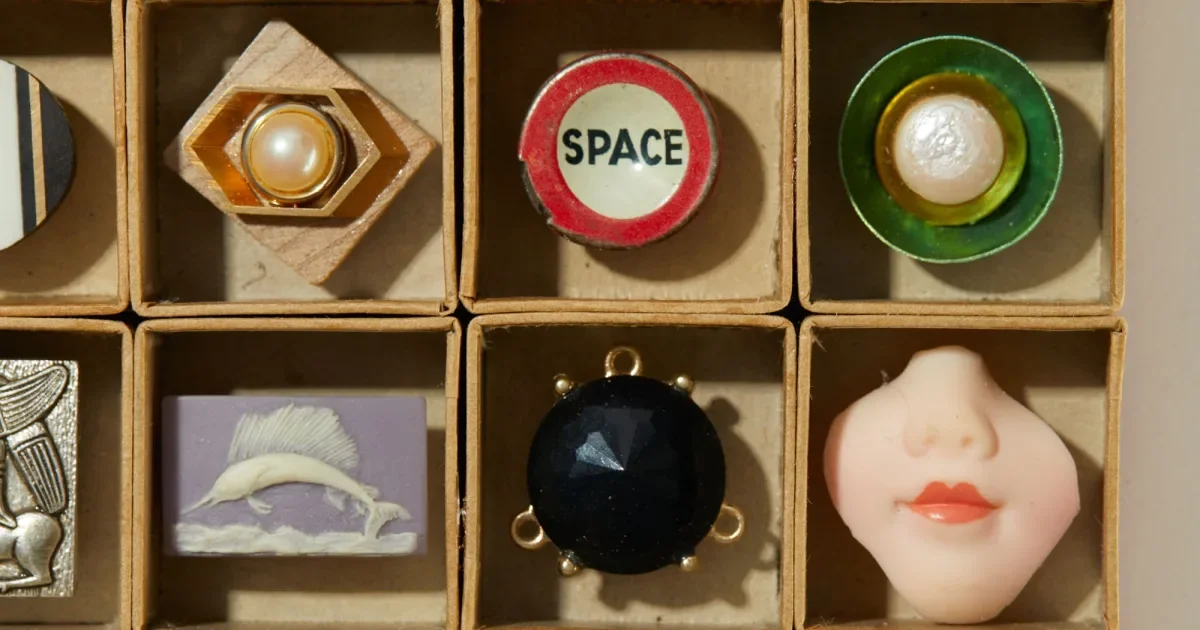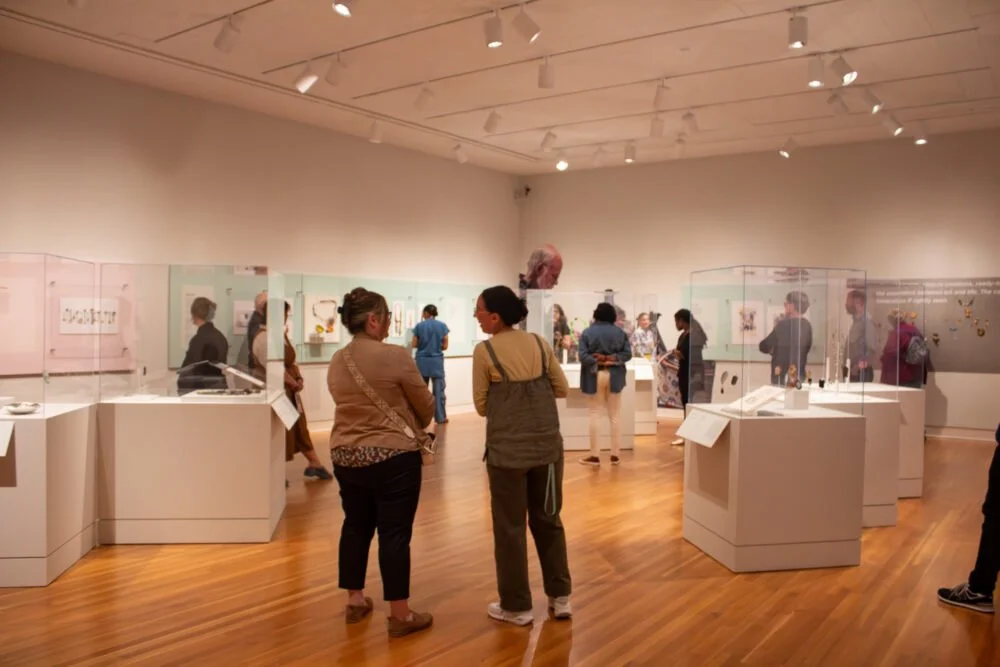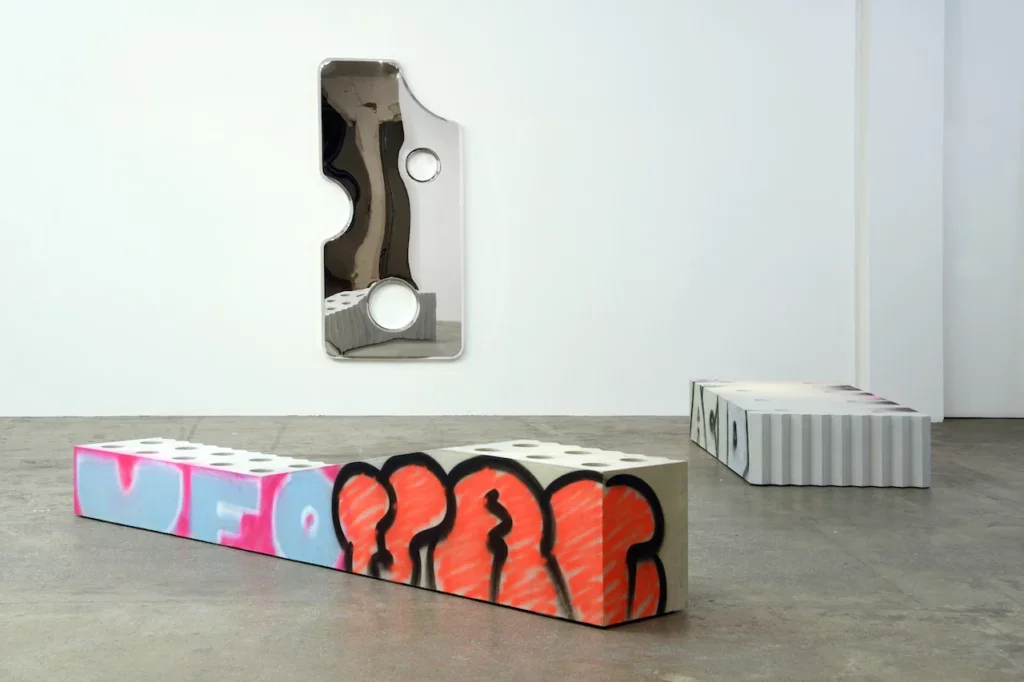Art Basel's Spectacle: A Critique of the Louis Vuitton x Takashi Murakami Hyperreality and a Case for Post-Luxury
The Louis Vuitton x Takashi Murakami Artycapucines bag, a centerpiece of the 2025 reunion at Art Basel Paris. This piece exemplifies the 'hyperreal' object, where the accessory transcends its function to become a "vibrant canvas," existing as a signifier of art and cultural spectacle.
As Louis Vuitton and Takashi Murakami reunite at Art Basel Paris 2025 to transform the iconic Capucines bag into a "vibrant canvas of contemporary art," the spectacle marks the apotheosis of a decades-long strategy within the luxury sector. This high-profile event, coming two decades after their groundbreaking first collaboration, occurs just as the global personal luxury goods market confronts a period of profound recalibration. After a remarkable post-pandemic boom that saw sales for top brands surge by over 80% between 2019 and 2024, the sector is now facing its first significant slowdown since the 2008-2009 financial crisis. This turbulence is not a momentary dip but has been identified as the sector's "new baseline". It is a systemic disruption fueled by a confluence of economic headwinds, geopolitical instability, and a palpable weakening of consumer sentiment across the globe's core markets. This report posits that this market correction is not merely an economic event but a symptom of a deeper philosophical crisis—a crisis of meaning born from the industry's own success in creating a hyperreal consumer landscape.
At the heart of this disruption is a phenomenon that can be termed a "quiet rebellion," driven by widespread "price fatigue". For years, luxury brands relied on consistent price increases to bolster their aura of exclusivity and drive growth. That strategy has now reached its ceiling, with escalating prices actively deterring demand, particularly from the aspirational consumers who once fueled the market's expansion. This has precipitated a "growing disillusionment" with luxury offerings, most acutely felt among younger generations—Millennials and Gen Z—who are fundamentally reassessing their relationship with luxury and questioning its long-standing price-to-value equilibrium. Consumers, in a word, are "fed up with big luxury fashion brands".
This sentiment is giving rise to two interconnected cultural movements: "Post-Luxury" and "quiet luxury." The Post-Luxury concept describes the decline of the "income-upgrade phenomenon," a paradigm shift wherein consumers no longer feel compelled to consistently upgrade to luxury goods as their income and wealth increase. Instead, they are making more deliberate, selective, and value-driven choices. This behavior finds its aesthetic expression in the trend of "quiet luxury," a conscious turn away from conspicuous logomania toward an appreciation for timeless design, superior craftsmanship, and sustainable, intentional consumption, a reaction against the conditions diagnosed in "The Luster Restored". It reflects a broader cultural shift, a "longing for the imperfect… for the antithesis of the clean, smooth, and homogeneous" that has defined mass-market luxury.
The aesthetic expression of "quiet luxury": a conscious turn toward timeless design, superior craftsmanship, and intentional consumption, valued for intrinsic quality over conspicuous branding.
To understand this crisis, one must look beyond market analytics to the cultural theory of Jean Baudrillard. This report will argue that the luxury industry, in its relentless pursuit of global growth, has perfected the creation of what Baudrillard termed a "hyperreal consumer landscape". In this state, the sign has completely replaced the real; the image of luxury has become more important than any tangible quality. Through decades of advertising, social media saturation, and the strategic deployment of logos, the sector has engineered an "effacement of reality". Objects are no longer valued for their utility (use-value) or even their symbolic meaning in a personal relationship (symbolic-value), but almost exclusively for their sign-value: their coded meaning within a self-referential system of prestige and status.
French philosopher Jean Baudrillard, whose theories on hyperreality provide a critical lens through which to understand the luxury industry's construction of a consumer landscape where the sign replaces the real.
The current market fatigue is the logical endpoint of this process. The system of signs, accelerated by digital media to an unprecedented degree, has become so saturated that it has begun to collapse under its own weight. When luxury branding becomes ubiquitous and democratized, its core promise of exclusivity is weakened. The sign becomes detached from any perceived substance, and consumers experience this void as "price fatigue" and "disillusionment". The quiet rebellion, therefore, is more than a trend; it is a subconscious attempt to rediscover "ontological authenticity" in a world where the real has been supplanted by its simulation.
This study will deconstruct this hyperreal system and propose an alternative framework for understanding value. Through a tripartite analysis of three distinct objects, it will build a case for a new paradigm: Post-Luxury Conceptual Functional Art (PLCFA).
The Foil: The Louis Vuitton x Takashi Murakami handbag, as the quintessential hyperreal object.
The Archetype: A handmade scarf, as the pure expression of authentic, narrative-driven value.
The Case Study: A Robert Ebendorf necklace, as the art-world validation of the PLCFA thesis.
By dissecting the problem and proving the existence of a viable alternative, this report will define a new way of navigating a world saturated with signs and starved of meaning.
The Foil — Deconstructing the System of Signs in Louis Vuitton x Takashi Murakami
The collaboration between French luxury maison Louis Vuitton and Japanese contemporary artist Takashi Murakami, first launched in 2003, stands as a seminal moment in modern fashion history. It was not merely a successful product launch; it was the perfection of a corporate strategy that transformed a luxury good into a cultural artifact of immense power. However, viewed through a critical lens, the Louis Vuitton x Takashi Murakami handbag is the apotheosis of the hyperreal object—a masterfully constructed sign whose value is entirely divorced from utility or intrinsic worth, existing solely within the coded "System of Signs" described by Baudrillard. It is the ultimate foil against which a new theory of value can be defined.
The Artification of the Monogram: A Strategy of Decommoditization and Hyperreality
The genesis of the collaboration was a strategic response to a fundamental threat facing the luxury industry at the turn of the millennium: commoditization. As brands like Louis Vuitton expanded into global markets with more accessible ready-to-wear collections, they risked diluting the very rarity and exclusivity upon which their value was built. Under the direction of Marc Jacobs, the house pioneered a "decommoditization strategy" known as "artification"—the process of treating a non-art object as art to imbue it with a renewed sense of prestige and "virtual rarity".
The choice of Takashi Murakami was a masterstroke. His "Superflat" theory, which deliberately collapses the distinction between "high" art and "low" commercial culture, provided the perfect philosophical vehicle for this corporate alchemy. Murakami was commissioned not to create a work of art, but to apply his aesthetic to a commercial product, lending the "aura" of his artistic brand to the Louis Vuitton brand. He brilliantly reimagined the house's staid monogram, creating a vibrant, 33-color palette on a stark white or black background that gave the classic bags a "tasteful yet hip look".
An example of Takashi Murakami's "Superflat" art. This theory, which deliberately collapses the distinction between "high" art and "low" commercial culture, provided the perfect philosophical vehicle for Louis Vuitton's "artification" strategy, lending the aura of fine art to a mass-market commodity.
The result was a quintessential hyperreal object: a mass-produced commodity that simulates the uniqueness and cultural capital of a work of art. Louis Vuitton's marketing campaign amplified this effect, generating immense hype that resulted in extensive waiting lists and cementing the bag's status as the definitive "must-have" accessory of the era. The strategy was not to sell a bag, but to sell a signifier of cultural relevance. The collaboration was a historical marker of the moment when the logic of the spectacle fully infiltrated the logic of luxury. Louis Vuitton's corporate need for a powerful new signifier was perfectly fulfilled by a rising media culture that was beginning to value the sign—the image of the celebrity with the bag—more than the object itself.
This strategy of artification is not a historical artifact but a living, evolving methodology, as evidenced by the announcement of the Artycapucines VII collection, a new collaboration with Murakami set to debut at Art Basel Paris 2025. Here, the iconic Capucines bag is transformed into a "vibrant canvas," with Murakami creating a series of fantastical, limited-edition pieces designed to "transcend accessory status to become art objects in their own right". The choice of venue—an elite international art fair—is a deliberate act of contextual reframing, designed to situate these commercial products within the discourse of high art. The collection, featuring surreal designs like the strass-studded Panda Clutch and the Capucines Mini Mushroom crafted with 3D-printed fungi, represents the hyperreal logic taken to its extreme: the bag is no longer a bag, but a sculpture, its function entirely subsumed by its new, art-coded sign-value.
Logomania as Code: Consumption, Status, and the Erasure of the Real
The Murakami bag became an indelible icon of the Y2K era, its cultural significance inseparable from the burgeoning celebrity and paparazzi culture of the time. Its constant presence on figures like Paris Hilton, Jessica Simpson, and Madonna, and its inclusion in cultural touchstones like the film Mean Girls, was not an incidental byproduct of its popularity but was central to its function as a sign.
The Louis Vuitton x Murakami bag's cultural significance was inseparable from the burgeoning celebrity and paparazzi spectacle of the Y2K era. Its constant presence on figures like Paris Hilton and in cultural touchstones like Mean Girls was central to its function as a sign, signifying access and status within a media-driven world.
In Baudrillard's framework, the bag operated entirely within a "System of Signs," where its value was derived not from any inherent quality but from its position within a differential system of prestige. The vibrant, instantly recognizable design was perfectly calibrated for its primary function: to be seen and photographed. It did not signify craftsmanship or durability in itself; it signified access, wealth, and inclusion within a media-driven spectacle. It was a tangible representation of the aspirational mantra, "Everybody wants to be us".
An analysis of the bag through Baudrillard's four distinct logics of value reveals its purely hyperreal nature:
Functional Value (Use-Value): Entirely nominal. The bag holds objects, but this utility is completely irrelevant to its cultural meaning and exorbitant price.
Exchange Value: Extremely high, yet fundamentally disconnected from its use-value or the cost of its materials and labor. Its price is a function of its sign-value.
Symbolic Value: Negligible. As a mass-produced consumer good, it is not a unique object exchanged between two subjects and imbued with the emotional weight of their relationship.
Sign-Value: Total and absolute. The bag's entire worth is derived from its status as a signifier of wealth, trend-awareness, and perceived exclusivity within the coded language of early 21st-century fashion. The sign-value has effectively cannibalized and erased all other forms of value.
The Legacy of the Spectacle: Nostalgia and the Re-edition as Simulacrum
The announcement of a re-edition of the collection for 2025, complete with a global campaign featuring the contemporary icon Zendaya, is the final confirmation of the object's hyperreal status. This revival is not a simple re-release of a beloved product; it is a second-order simulacrum—a copy that no longer has any reference to an underlying reality, but only to other signs.
The 2025 re-edition campaign, featuring contemporary icon Zendaya, confirms the bag's hyperreal status. This revival is a "second-order simulacrum": a copy of a past sign, selling manufactured nostalgia for the Y2K era. It is a perfect example of Baudrillard's theory where the map (the simulation) now generates the territory (our cultural reality).
The original 2003 bag was already a simulation, a signifier that stood in for the concepts of "art" and "social status." The 2025 re-edition is a copy of that sign. Its value is derived not from the object itself, but from a manufactured nostalgia for a past cultural moment (the Y2K era) that was itself a spectacle constructed and disseminated by mass media. The new campaign does not sell a product; it sells a simulation of a past simulation. It is a perfect illustration of Baudrillard's precession of simulacra, a state where the map precedes the territory and, eventually, generates it. The Louis Vuitton x Murakami collaboration did not just reflect the culture; it actively produced it, creating a world where the sign of luxury became more real than the thing itself, a process that has led directly to the crisis of meaning and value the industry faces today.
The Archetype — Locating Authenticity in 'The Garden of Art' Scarf
The archetype: 'The Garden of Art' scarf. Unlike a mass-produced commodity, its profound value is intrinsic, narrative, and deeply personal. It is an object of "symbolic exchange," grounded in the labor of its creation and the haptic memory it evokes, existing entirely outside the hyperreal "System of Signs."
To escape the self-referential hall of mirrors that is the hyperreal, one must turn to objects that exist entirely outside its logic. The archetype of such an object is 'The Garden of Art' scarf—an item whose profound value is intrinsic, narrative, and deeply personal. It serves as the philosophical and emotional core of the Post-Luxury thesis, demonstrating a system of worth grounded not in coded signs but in human connection, labor, and memory. By dissecting the sources of its value, we can establish the foundational principles of the "Object of Affection."
The Aura of Creation: Labor, Love, and the Psychology of the Gift
In stark contrast to the industrially produced, globally marketed Louis Vuitton bag, the value of 'The Garden of Art' scarf begins with the irreducible fact of its creation. It is a physical manifestation of unquantifiable resources: time, focused effort, and the personal touch of its maker. This "labor of love" is immediately perceptible to the recipient, signaling a level of care and personalized attention that mass-produced goods cannot replicate. The very act of creating something by hand for another person is an "act of service," a tangible expression of affection that transcends mere transaction.
This places the scarf within the framework of a "gift economy," a system of exchange that prioritizes the strengthening of social bonds and reciprocity over monetary profit, as theorized in "Value Beyond Price". The value of the scarf is not its market price—which is nonexistent—but the social and emotional capital it generates: a reinforced sense of connection, gratitude, and mutual respect. This aligns perfectly with Baudrillard's own theoretical alternative to the commodity system of sign-value: the concept of symbolic exchange. The scarf is a true symbol, exchanged between two specific subjects and imbued with the unique, ambivalent, and emotionally resonant meaning of their relationship. It is not a sign to be decoded by an impersonal, external system of status.
Furthermore, the act of making is psychologically formative for the creator. Drawing on the philosophies of 19th-century thinkers like John Ruskin and William Morris, who argued that engaging in handicrafts was a process through which workers "created themselves," the scarf can be understood to contain the "aura" of its maker. Their skill, commitment, judgment, and intention are physically embedded in the object, making it a unique and irreplaceable artifact of human creativity.
Haptic Memory and the Narrative Object
A crucial, yet often overlooked, dimension of the scarf's value lies in its tactile reality. To fully grasp this, one must introduce the concept of haptic memory: the form of sensory memory specific to the stimuli of touch. While the Louis Vuitton bag functions primarily as a visual sign, meant to be seen from a distance, the scarf is fundamentally a haptic object, designed to be felt against the skin.
The concept of "haptic memory"—the sensory memory of touch. Unlike a visual sign, an "Object of Affection" is grounded in its tactile reality. Its value is encoded and accessed through its specific physical properties, anchoring the user's experience in authenticity and offering a powerful defense against the disembodied hyperreal.
Its value is encoded and accessed through its specific physical properties: the particular texture of the yarn, its weight and density, its capacity for warmth, and its subtle, handmade imperfections. These are not flaws in a manufacturing process; they are data points that constitute the object's unique story and identity. This deep, tactile connection between the wearer and the object's layered history is what the PLCFA framework identifies as the "haptic memory" of an object. The physical sensation of wearing the scarf acts as a powerful trigger for emotional and narrative recall—it evokes the memory of the person who made it, the moment it was given, and the feeling of their care.
This sensory grounding in physical reality makes the scarf the ultimate anti-hyperreal object. Its meaning is not a free-floating sign circulating in a media landscape, but is physically embedded in its material substance, accessible through the direct, unmediated experience of touch. The emotional connection to an "Object of Affection" is not merely a sentimental abstraction; it is a neurological process anchored by haptic memory. The hyperreal operates primarily in the disembodied realms of the visual and the conceptual—images and codes that simulate reality. Haptic memory, by definition, is embodied; it is the brain's record of direct, physical interaction with the world. The unique haptic data of a handmade object provides a neurological anchor to authenticity, grounding our experience in tangible reality and offering a powerful defense against the disorienting abstractions of the hyperreal.
Symbolic Exchange vs. Sign-Value: The Unknowable Worth
A direct comparison of 'The Garden of Art' scarf and the Louis Vuitton bag using Baudrillard's four-part value system crystallizes their diametrically opposed natures:
Functional Value (Use-Value): Essential. The scarf provides warmth. Its function is integral to its identity and its narrative of care.
Exchange Value: Zero. It exists entirely outside the logic of the market and cannot be meaningfully commodified.
Symbolic Value: Total. Its entire worth is derived from its status as a unique symbol of a specific relationship and a specific act of creation. Its meaning is relational and deeply personal.
Sign-Value: Zero. To the external system of luxury codes, the scarf is illegible. It signifies nothing of status, wealth, or trend-awareness.
'The Garden of Art' scarf is the epitome of the "quiet" object sought by the Post-Luxury consumer. Its immense worth is private, authentic, and completely detached from the "hallucinatory resemblance of the real" that characterizes the System of Signs. It stands as definitive proof that an alternative value system, rooted in human connection and tangible reality, is not only possible but is a deeply felt human necessity.
The Case Study — Validating the Thesis in the Studio Jewelry of Robert Ebendorf
The argument for a value system based on narrative and authenticity, as embodied by 'The Garden of Art' scarf, could be dismissed as purely sentimental or private. To prove that these principles can form the basis of a formal, critical, and public practice, this analysis now turns to the work of American artist Robert Ebendorf. As a seminal figure in the studio jewelry movement, Ebendorf's career provides the definitive case study, demonstrating how the personal, narrative-driven ethos of the "Object of Affection" can be elevated into a validated art form. His work is the "proof" that Post-Luxury Conceptual Functional Art exists as a recognized and influential movement.
A brooch by Robert Ebendorf, a seminal figure in the studio jewelry movement. His work validates the PLCFA thesis by trading conventional "preciousness" for narrative depth, "making order and beauty out of chaos" by combining materials like butterfly wings with diamonds, intentionally breaking the rules to create new forms of value.
The Alchemist of the Overlooked: A Rebellion Against Preciousness
Robert Ebendorf's work must be understood within the context of the American studio jewelry movement, which emerged in the mid-20th century as a philosophical rebellion against the commercial jewelry industry. With historical roots in the 19th-century Arts and Crafts movement's critique of industrialization, studio jewelry rejected the prevailing emphasis on mass production and the intrinsic value of precious materials. It championed instead individual artistic expression, innovative design, and the use of unconventional materials.
Ebendorf is a cornerstone of this tradition. His artistic ethos is encapsulated in his enduring statement, "My work has been and is about making order and beauty out of chaos". His practice is a conscious and sustained rebellion against the conventional definition of "preciousness". He famously articulated this philosophy as being "about not being afraid to put diamonds and pearls with broken glass and bone". This is not the rebellion of an outsider; Ebendorf first mastered traditional goldsmithing techniques, acquiring an impeccable classical foundation that lends authority to his subsequent decision to intentionally break those rules, trading material purity for narrative depth. This historical lineage of aesthetic rebellion—from Arts and Crafts versus industrialization, to studio jewelry versus commercialism, to Ebendorf versus consumerism—provides a powerful intellectual foundation for the contemporary Post-Luxury movement's reaction against hyperreality. The PLCFA framework is the theoretical articulation of this recurring historical impulse, adapted for the unique challenges of our time.
Material as Story: The Ethics and Aesthetics of Assemblage
At the core of Ebendorf's practice is the principle of "Material as Story". He is a self-proclaimed "gleaner," and his creative process begins not in a mine or a showroom, but on the street, at the beach, or in a dumpster. His material palette consists of the "discarded detritus of modern life": crab claws, sea glass, plastic buttons, rusted beer bottle caps, old tintype photographs, and recycled industrial objects.
This act of finding and reclaiming is both an aesthetic and an ethical choice. Ebendorf's work elevates objects based on their "ethical provenance"—the history they already carry within them. By reconfiguring these de-valued materials, he gives them "new value" and a "new life," offering a profound and tangible critique of our culture's consumerism and planned obsolescence
A detail of found objects used by artist Robert Ebendorf, buttons, trinkets, and fragments of everyday life, demonstrating his philosophy of “Material as Story,” where narrative and ethical provenance replace conventional notions of preciousness.
"Objects of Affection": Functionality as a Conceptual Framework
Gallery view of Objects of Affection: Jewelry by Robert Ebendorf, an exhibition exploring intimacy, memory, and material transformation through contemporary jewelry practice.
The functionality of Ebendorf's work—its existence as wearable jewelry—is critical to its conceptual power. By creating brooches, necklaces, and bracelets, he grounds his radical material critique in the human body, creating an intimate relationship between the object and its wearer. This aligns perfectly with the "Conceptual Functional Art" component of the PLCFA framework. His pieces embody "de-branding as authenticity"; their value is self-evident in their craft and story, requiring no external logo to signify their worth.
The ultimate validation of this entire thesis is provided by the art world itself. A major, career-spanning retrospective of Ebendorf's work, organized by the Mint Museum, is literally titled "Objects of Affection: Jewelry by Robert Ebendorf". This title is not a coincidence; it is a curatorial acknowledgment of the core principles that have guided his six-decade career. The exhibition and the prestigious collection it draws from confirm that the values embodied by the "Archetype"—the celebration of objects for their narrative, their history, and the emotional connections they foster—are not confined to the private, sentimental sphere. These values form the bedrock of a formal, critical, and institutionally recognized art practice that has both market and museum validation. The Robert Ebendorf brooch is the definitive proof that the PLCFA thesis is not a mere proposition but a living, breathing, and vital artistic tradition.
Toward a Theory of Post-Luxury Conceptual Functional Art (PLCFA)
The preceding analysis has traced a path from the hollow spectacle of hyperreal luxury to the authentic core of the handmade object, and finally to the validation of that authenticity within a formal art practice. By juxtaposing the Louis Vuitton x Murakami handbag, 'The Garden of Art' scarf, and the Robert Ebendorf brooch, a clear and compelling argument emerges. The current crisis in the luxury market is a crisis of value, born from a system that has privileged the sign over substance for too long. In its wake, a new framework is needed to identify and articulate what constitutes true, lasting worth. This report proposes Post-Luxury Conceptual Functional Art (PLCFA) as that framework.
Synthesizing the Triad
The three objects at the center of this study form a complete dialectical argument, each operating within a distinct value system. The Louis Vuitton bag demonstrates the logic of the System of Signs. Its functional value is nominal, completely irrelevant to its worth, which is derived from a conceptual value rooted in corporate strategy—the "artification" of a brand to generate new sign-value. As the epitome of logomania and conspicuous consumption, it is the antithesis of Post-Luxury. In contrast, 'The Garden of Art' scarf establishes the enduring human need for Symbolic Exchange. Its function is essential to its narrative of care, and its conceptual value is total, derived entirely from the story of its creation and the relationship it represents. With zero sign-value, it is the definition of a "quiet," Post-Luxury object. Finally, the Robert Ebendorf brooch proves that this intrinsic, narrative-based value can be translated into a formal, critical practice of Conceptual Functional Art. Its function as wearable art is critical to its power, and its conceptual value lies in its philosophical critique of material preciousness. As a masterclass in replacing extrinsic codes with intrinsic worth, it is a foundational example of the Post-Luxury movement, deriving its primary value from narrative and craft.
Defining the PLCFA Framework
Post-Luxury Conceptual Functional Art is a framework for identifying, creating, and valuing objects in an era defined by the collapse of traditional luxury codes. It is not a style, but a methodology for assessing worth based on a set of core principles:
Installation view exploring the language of Post-Luxury Conceptual Functional Art (PLCFA)—where industrial form, urban expression, and utilitarian function intersect to redefine value as conceptual rather than material.
Post-Luxury: A conscious and critical rejection of value systems predicated on conspicuous consumption, logomania, and extrinsic sign-value. It prioritizes intrinsic qualities over external brand signals.
Conceptual: The primary source of an object's value is immaterial. It is derived from the narrative of its creation, the history embedded in its materials, the intent of its maker, and the philosophical critique it embodies.
Functional: The object's utility is not incidental but is essential to its identity. Its function—whether as a garment, a tool, or an adornment—grounds its conceptual weight and forges a direct, often haptic, relationship with its user, anchoring it in the real world.
Art: The object demonstrates a mastery of craft and an intentional aesthetic transformation. The skill of the maker elevates the object beyond mere utility or sentiment, turning it into a carrier of profound meaning and lasting beauty.
The Framework as a Navigational Tool
In a market landscape defined by turbulence, price fatigue, and a growing disillusionment with the hyperreal, the PLCFA framework offers more than just a critique. It is a practical and necessary navigational tool for consumers, creators, and critics alike. It provides a robust methodology for cutting through the noise of the spectacle and identifying true, lasting worth—a value system rooted not in the fleeting codes of status, but in the enduring qualities of authenticity, narrative, and the irreplaceable human touch.

